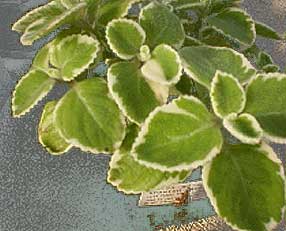|
THYME:
 An aromatic, evergreen shrub,
thyme and its equally
popular relative lemon thyme has been a popular herb
for millenia. Native to the northern and eastern
Mediterranean shores, it has a mild, sweet and
slightly spicy flavour. Lemon thyme has lemon scented
leaves. Because it can be grown in temperate climates
it is now a favourite herb used by chefs and cooks to
flavour and garnish all kinds of foodstuffs. It is
also one of the essential ingredients in bouquets
garnis. While thyme goes well with any dish - meat,
vegetable and dairy, in soups, with stuffings, in
marinades and sauces and with pasta - it enhances the
flavour of pizzas and dishes with cheese toppings. An
antiseptic containing thymol, it works well as a cough
remedy, so a tea made from both common thyme and lemon
thyme is both refreshing and soothing to the throat.
Another herb that can be grown both indoors and
outdoors, it should survive even the harshest winter.
But thyme prefers a light, well-fertilised soil (with
seaweed preferably) in full sun. If grown indoors it
needs a rich sandy soil that has been well manured. It
needs to be fed throughout the winter with liquid
seaweed or liquid compost.
An aromatic, evergreen shrub,
thyme and its equally
popular relative lemon thyme has been a popular herb
for millenia. Native to the northern and eastern
Mediterranean shores, it has a mild, sweet and
slightly spicy flavour. Lemon thyme has lemon scented
leaves. Because it can be grown in temperate climates
it is now a favourite herb used by chefs and cooks to
flavour and garnish all kinds of foodstuffs. It is
also one of the essential ingredients in bouquets
garnis. While thyme goes well with any dish - meat,
vegetable and dairy, in soups, with stuffings, in
marinades and sauces and with pasta - it enhances the
flavour of pizzas and dishes with cheese toppings. An
antiseptic containing thymol, it works well as a cough
remedy, so a tea made from both common thyme and lemon
thyme is both refreshing and soothing to the throat.
Another herb that can be grown both indoors and
outdoors, it should survive even the harshest winter.
But thyme prefers a light, well-fertilised soil (with
seaweed preferably) in full sun. If grown indoors it
needs a rich sandy soil that has been well manured. It
needs to be fed throughout the winter with liquid
seaweed or liquid compost.
For the vegan,
thyme is a herb that can experimented
with. It should be an essential ingredient of every
salad, a little sprinkled on each bowl, but its
flavour will be best appreciated in bean and vegetable
soups and stews. It also goes well as a garnish with rice.
|

